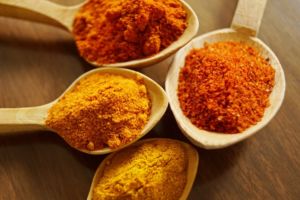Millions of Americans live with some form of arthritis. There are over one hundred different types of arthritis, but all of them cause painful, stiff, and sometimes swollen joints. Over-the-counter pain medications like ibuprofen and Tylenol are necessary for managing arthritis pain that gets in the way of daily activities, but taking these drugs regularly can cause serious side effects. Here are three ways to manage arthritis symptoms safely so that you can reduce your use of NSAIDs and other pain medications.
Note: If an autoimmune condition causes your arthritis, you should continue taking your medication as prescribed, but the tips in this article can help you feel better.

1. Use Nature’s Anti-Inflammatories
Inflammation is one of the key causes of arthritis pain. It is also the root cause of many other diseases, including autoimmune illnesses and cancer. Luckily, nature is full of herbs and foods that encourage a healthy inflammatory response. Two of the safest and most effective are ginger and turmeric.
There are many supplements on the market that contain curcumin, one of the active chemical compounds in turmeric. Curcumin is difficult for the body to absorb, so it needs to be mixed with other compounds to make it accessible. Nature has provided the answer to this problem, too: black pepper. Piperine, a chemical in black pepper, has health benefits on its own, including anti-inflammatory properties. Piperine also helps with curcumin absorption, and using the two together enhances their benefits. When shopping for a curcumin or turmeric supplement, choose one that includes black pepper. You can also reap the benefits of turmeric by mixing the whole root and some black pepper kernels into smoothies or adding them to recipes. Studies have found that turmeric worked better than a placebo for treating arthritis pain.
Ginger is in the same family as turmeric and boasts powerful anti-inflammatory properties. It’s been used in traditional medicine for centuries to treat nausea, pain, head colds, and indigestion. You can take a ginger supplement or eat candied ginger to get some of these benefits. The fresh root can also be used to make tea or added to smoothies and recipes. A study in 2000 found that ginger extract was just as effective as ibuprofen for managing arthritis pain. Several studies since then have confirmed its pain-fighting properties. One study in 2015 found that creams containing ginger were effective for osteoarthritis pain of the knee when applied topically.
Both ginger and turmeric are safe for most people (but you should talk to your doctor first if you have a health condition or take medication). They also have antioxidant and anticancer properties and may be good for brain health.

2. Eat More Fat
Good fat that is. While bacon won’t help with your arthritis pain (sorry), fats found in fish, walnuts, and flax seed will. These are Omega-3 fatty acids, and they have anti-inflammatory properties that help with joint pain. Omega-3 fats are also an ingredient in the lubricant within your joints, so eating more can help keep joints working smoothly.
It’s important to pay attention to the ratio of omega-6 vs. omega-3 fats in your diet. Omega-6 fats aren’t bad for you in moderation– they are considered healthy fat– but most Americans eat too many omega-6 fats and not enough omega-3s. Omega-6 fats are found in most plant-based cooking oils, including canola, soy, sunflower, and corn. This means that potato chips and other packaged foods are typically high in omega-6 fats. The ideal ratio of omega-3 to omega-6 fats in your diet is somewhere around 1:4. The typical American diet looks more like 1:16. Scientists believe that this imbalanced ratio encourages inflammation.
You can make some simple changes to bring your omega-3 levels up and your omega-6 levels down. Try eating grass-fed meat, taking fish oil supplements, or adding more seafood to your diet. You can also eat plant-based sources of omega-3, including flax seeds and walnuts. To cut back on your omega-6 intake avoid packaged fried foods and fast foods.
Studies show that fish oil supplements significantly decrease swelling and pain in arthritis patients. You may need a high dose of fish oil every day to see results, so you should talk to your doctor about safety if you are already taking medications or have a bleeding disorder. Even high doses of fish oil are safe for most people.

3. Consider K-Laser Therapy
Topical treatments have been popular for arthritis pain for decades, but many don’t provide effective relief. But what if there was a topical, non-invasive treatment that worked in the joint itself? K-laser therapy uses red and near-infrared light to stimulate blood flow and cellular regeneration. Joints often don’t receive robust blood flow, making it hard for them to heal and easy for them to be damaged. K-laser therapy brings blood flow to the area and encourages natural healing. Arthritis can’t be cured, but K-laser therapy relieves pain, inflammation, and stiffness and may slow the progression of symptoms. Several studies have proven its effectiveness for patients with arthritis. Most patients felt improvement in their pain after every treatment.
K-laser therapy is comfortable, safe, and quick. Treatments take less than 20 minutes. After receiving an initial set of treatments, some arthritis patients only need treatment once a month or less to keep up their results. Laser therapy has helped many arthritis patients reduce their intake of pain medications and feel better during everyday activities.
Arthritis Treatment in Tennessee
At Stanlick Chiropractic, we provide our patients with personalized treatment for arthritis pain. Our providers counsel patients on nutrition and lifestyle changes and use cutting-edge treatments like K-laser therapy. Schedule a consultation today to find out how we can help you experience less pain.

